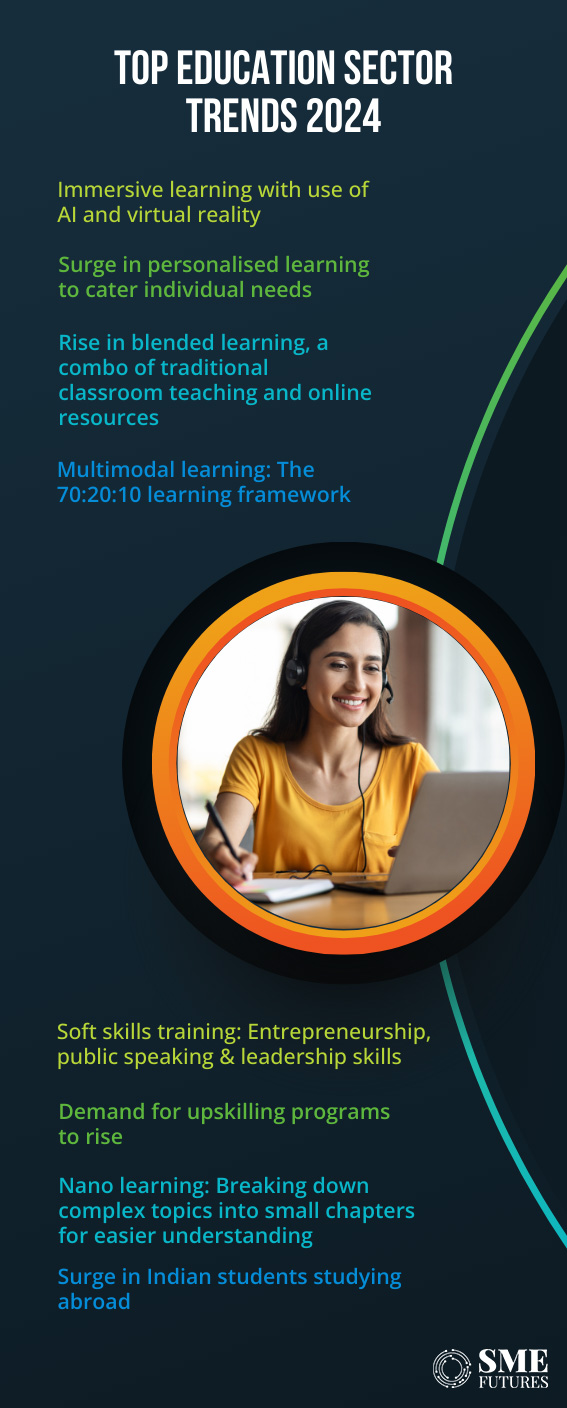The vast landscape of Indian education, which boasts of a staggering 14.89 lakh schools, catering to over 26.52 crore students guided by 1.13 crore teachers, has been witnessing tremendous transformation of late. The digital revolution has made the education market rife with possibilities.
According to market research reports, in 2020, the market size of the education industry was about $117 billion across India. This is estimated to rise up to $225 billion by 2025. As we navigate through the evolving landscape of Indian education, 2024 promises to be a transformative year, marked by key sectoral trends. Let’s delve into the insights provided by industry stakeholders, offering a glimpse into the exciting future of education.
It’s time for an upgrade
Although the pandemic has transformed the education system, it’s time for an upgrade.
Dr. Nilesh Gokhale, Director, Thakur Global Business School, Kandivali, Mumbai, says, “The fusion of technology and education is no longer a choice but a necessity, and we anticipate a surge in innovative learning methodologies.”
According to the stakeholders, in 2024, the education sector is likely to witness technological advancements.
“It’s on the brink of a profound transformation, and the role of technology in upskilling is more crucial than ever. We should envision a future where technology seamlessly integrates into a hands-on learning journey, empowering individuals to thrive in a rapidly evolving digital landscape,” says Giridhar LV, CEO and Co-Founder, Nuvepro Technologies.
Kavita Sharma, Co-Founder and CEO, Ziyyara Edutech, adds, “The integration of immersive technologies, such as virtual and augmented reality, is anticipated to create more engaging learning environments. This shift could make complex subjects more accessible and foster hands-on experiences, enriching the overall learning process.”
Tech in higher education
Talking about technology inclusion in STEMS, Dr Sarvjeet Herald, Director, India STEM Foundation says that the infusion of emerging technologies such as Robotics, AI and Virtual Reality (VR), will be instrumental in transforming the STEM education landscape.
“Robotics will synchronise the eyes, hands, and mind movements of students to express design thinking, problem solving and creativity. AI algorithms will facilitate adaptive learning platforms, offering personalised content recommendations based on individual progress and learning styles. VR, on the other hand, will provide immersive simulations, allowing students to explore complex concepts in a three-dimensional space,” he contends.
Speaking about tech in management studies, Gokhale points out that the role of AI and Machine Learning (ML) will be more pronounced, not only in automating administrative tasks but also in revolutionising management practices and the decision-making process itself.
“To address the dynamic demands of the future workforce, the key lies in staying agile and adapting swiftly to emerging technologies. Online courses, webinars, industry forums, and networking events provide ample opportunities to aspiring management students to expand their knowledge and stay ahead of the curve,” he avers.
Partnerships between educational institutions, industry players, and tech innovators will drive holistic education, ensuring that students are not just equipped with knowledge but also with critical thinking and problem-solving skills.

Personalised learning to surge
2024 is expected to witness a surge in personalised learning, in accordance with the diverse learning styles of students.
Dr Herald says, “Recognising that students have unique learning styles and paces; educational institutions will need to integrate tailored approaches to cater to individual needs. This shift involves leveraging technology to provide adaptive learning experiences that resonate with diverse student backgrounds and abilities.”
According to him, experiential and hands-on activities will take centre stage, fostering a more interactive and engaging learning environment.
“Students will have the opportunity to apply theoretical knowledge in practical scenarios and demonstrate their ideas, imaginations and creations through platforms such as the World Robot Olympiad. This not only enhances comprehension but also cultivates problem-solving skills crucial for their future endeavours,” he asserts.
Sharma agrees, saying, “Personalised learning will be a key focus, leveraging artificial intelligence to tailor educational content to individual student needs. This approach aims to enhance engagement and address diverse learning styles.”
This shift could make complex subjects more accessible and foster hands-on experiences, enriching the overall learning process, she adds.
Blended learning for education
Stakeholders anticipate a continued rise in blended learning, a combination of traditional classroom teaching and online resources.
Sharma says that blended learning, a mix of traditional classroom teaching and online resources, will continue to gain prominence, offering students a flexible and interactive learning experience.
“Global collaboration and cross-cultural education initiatives are expected to grow, facilitated by digital platforms that connect students and educators worldwide. This trend aligns with the increasing importance of preparing students for a globally interconnected world,” she says.
Moreover, the emphasis on developing critical thinking, problem-solving, and digital literacy skills will remain a priority, reflecting the evolving demands of the job market.
India’s ascendance as hub for international students
In 2024, India is poised to become the biggest source market for international students, surpassing China.
The data reflects a shifting landscape, with India already claiming the top position in Canada, boasting 319,000 students compared to China’s nearly 100,000. The United States, currently hosting 262,000 students from China and 253,000 from India, is on the brink of witnessing India surpass China as the foremost exporter of students to its shores.
Patriek Karayil, President, American Colleges, says, “Projections for the UK and Australia indicate a narrowing gap between the Indian and Chinese student populations, a trend likely to redefine the dynamics of student migration in the coming years.”
Beyond the statistics, several factors contribute to this surge in Indian students studying abroad.
Universities are fostering accessibility, governments are facilitating practical experiences through post-study work permits, and new fintech firms are innovating to make education abroad more affordable for Indian families.
“This triumvirate of accessibility, practicality, and affordability is propelling India into a position of unprecedented demand for education in destination markets. As India becomes the epicentre of global competition for students, the resulting on-ground presence of foreign universities ensures that students have an expanded array of choices, heralding an era of increased access and diversity in international education,” he points out.
Upskilling to soar in 2024
In 2024, stakeholders foresee a paradigm shift in the way that educators approach education for the needs of skilling.
Giridhar L V shares that in the coming year, personalised and adaptive learning experiences, driven by artificial intelligence and immersive technologies, will take centre stage. “The goal would be to deliver dynamic, industry-relevant curricula that not only address the current skill gaps but also anticipate future workforce demands,” he says.
According to him, the demand for upskilling programmes is set to soar in 2024, bridging the divide between traditional education and the dynamic needs of industries.
“Our focus is on leveraging cutting-edge technologies to create a learning ecosystem that equips the workforce in getting job and project ready. Collaborations with businesses, educational institutions, and skilling providers will be key as we strive to lead the way in shaping a workforce that not only meets industry standards but sets new benchmarks for excellence in the digital age by being project and job ready from day one,” he shares.
To address the dynamic demands of the future workforce the key lies in staying agile, adapting swiftly to emerging technologies, and, most importantly, keeping the student at the heart of all educational endeavours.
As we approach 2024, the educational landscape is set to evolve, propelled by innovation, technology, and a commitment to meeting the dynamic needs of students and the workforce. The anticipated trends reflect a collective effort to create an educational ecosystem that is adaptive, engaging, and prepares individuals for success in a rapidly changing world.










